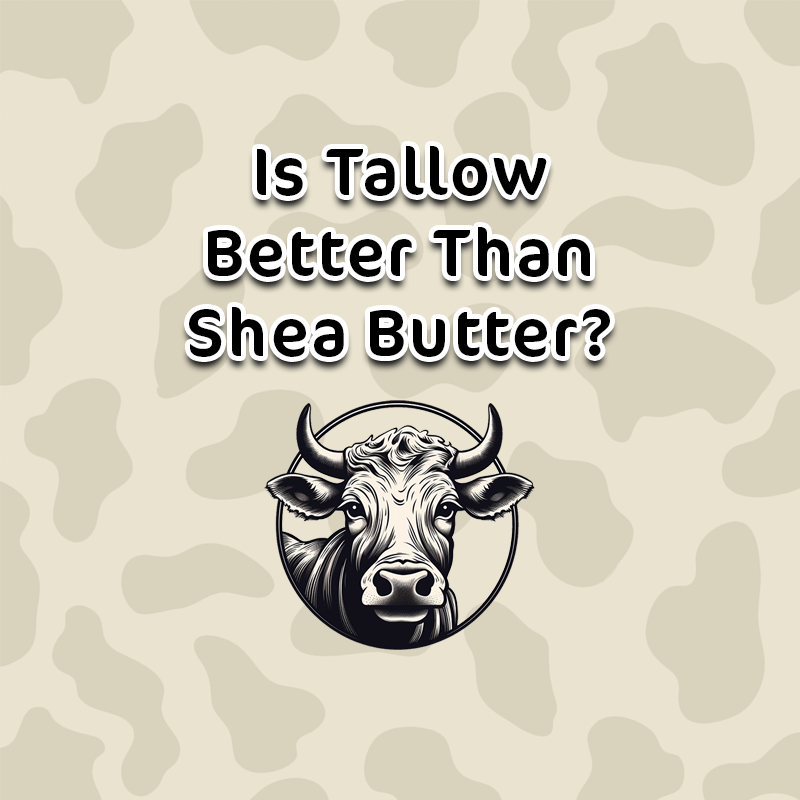Is Tallow Better Than Shea Butter? Exploring Myths and Benefits

Hey there, fellow skincare enthusiasts!
If you're anything like us, you've probably caught wind of the chatter surrounding tallow and shea butter in the skincare realm. These ingredients have been causing quite a stir due to their potential perks. Tallow, derived from animal fat, and shea butter, extracted from shea tree nuts, have amassed a fan base. But the big question is: Which one's the winner in the skincare routine? Well, in this conversation, we're delving deep into these ingredients, busting myths left and right, and uncovering their enchanting qualities to help you decide whether tallow or shea butter is your skin's true pal.
Meet Tallow and Shea Butter 🐄

Let's start at the beginning. Tallow has been around for ages, sourced from animals like cows or sheep. It's been used in various applications, including skincare. Think of it as your skin's trusty companion, loaded with saturated fats that gift it that luxurious texture we adore. Oh, and the bonus? Tallow carries some goodies too – vitamins A, D, E, and K – the gang known for pampering our skin. It's like a prime candidate for your skincare routine.
Now, onto shea butter! Emerging from the African shea tree, this nutty wonder is jam-packed with fatty acids like oleic and stearic acid. Translation: It's the superhero of hydration. Shea butter takes emollient living to the next level, making it your go-to for locking in moisture like a champ. Oh, and those vitamins? They're present too – A and E, accompanied by a bunch of antioxidants. It's like a nutritional feast for your skin! Whether you're dreaming of supple skin or aiming to conquer the world with your luminous radiance, shea butter's got your back.
Time to Bust Some Myths!🧐
Myth 1: Tallow Is Too Heavy for the Skin 🤔
Ever heard the rumour that slathering tallow on your face is akin to hosting a butter party – heavy and oily? Yeah, me too. This misconception stems from Tallow's saturated fats, which might raise concerns about pores going on strike. But wait a sec – let's unravel this tale together. The story hinges on the origin and processing of this magical ingredient. The creme de la creme comes from content cows feasting on grass. And here's the twist: processing. That's the enchanted recipe for transforming regular fat into a skin-loving superstar. And the magical part? When done right, voila! No heavy or greasy vibes!
Myth 2: Tallow is Only Suitable for Dry Skin
Hold on tight – Tallow isn't just riding in on a white horse to save dry skin, contrary to popular belief. Yeah, I've heard the murmurs too. But guess what? Tallow has a few tricks up its sleeve. Those emollient and soothing properties? They're not exclusive. Nope, they're ready to mingle with all skin types. So, don’t write it off just yet. It turns out that well-crafted tallow products could be the secret sauce your skin's been craving.
Myth 3: Tallow is Harmful to the Environment🌍
Some folks are raising the alarm about tallow production, suspecting it's a party pooper in the environmental realm due to concerns about animal agriculture. And I'm with you – the environment's a big deal. But here's the twist: Tallow can also tag along as a sidekick to sustainable and ethical meat production. Plus, the skincare industry is leaning towards ethical sourcing and transparency in ingredient origins.

Myth 4: Tallow is Greasy and Unpleasant to Use😣
Let's chat about Tallow's image problem. I mean, the "greasy" label? It's like that persistent rumour that just won't quit. But here's the real deal – sure, Tallow boasts saturated fats that lend it that lush texture. But before you shove it into the closet of passé trends, hear this out. Formulations have had a makeover. They've mastered the art of straddling the line between richness and absorption. Say hello to refined Tallow products – the Goldilocks of skincare, providing nourishment without the clingy residue. It works great as part of your morning skincare routine getting you ready for whatever the weather will throw at you!
Myth 5: Shea Butter Causes Breakouts🙅♀️
Let's set the record straight about shea butter. It's been taking some heat for a crime it didn't commit. Yep, the acne rumour. Apparently, folks think it's booked a one-way ticket to breakout town due to its high-fat content. But here's the scoop: the "comedogenic rating" isn't the be-all and end-all of your skin fate. It boasts a snazzy combo of fatty acids that play superhero, alongside anti-inflammatory and moisturising powers. And guess what? They're all about harmony on your skin – think calming and balancing, potentially sending those pesky breakouts packing. Who knew shea butter was the unsung hero in the battle against blemishes?
Myth 6: All Shea Butter Products are Created Equal
Here's a sneaky misconception to debunk – not all shea butter goodies are cut from the same cloth. Do you know why? The quality game is real. Imagine it like this: not all pizzas are crafted alike, and the same goes for shea butter. A whole adventure's happening behind the scenes – where those nuts come from, how they're treated, and even the extra company they keep. So, next time you're eyeing a dose of shea butter goodness, channel your inner detective and investigate the ingredients. Quality shea butter is where the enchantment happens, so don't settle for anything less.
Myth 7: Shea Butter is Only for Dry Skin
Let's squash the notion that shea butter's reserved exclusively for dry-skinned souls. While its emollient prowess is a blessing for parched skin, its gifts extend to various skin types. Normal, combination, sensitive – everyone's invited to the shea butter party. It's like an inclusive bash where all skin types can benefit.
Comparing Benefits
Tallow's Benefits:
Skin Compatibility: Tallow enthusiasts highlight its resemblance to human skin lipids, which may translate to smoother absorption and a potential boost to the skin's protective barrier. This makes products like tallow face cleanser a savvy choice for enhancing natural skin function.
Vitamin Content: With vitamins like A, Tallow holds promise for skin health, assisting in cell regeneration and repair. This is especially beneficial in formulations like tallow face cream with almond oil, which are crafted to leverage these nourishing properties.
Emollient Goodness: The richness of Tallow makes it a heavy hitter in the moisturisation game, especially for dry or sensitive skin types. When combined with the detoxifying properties of charcoal tallow soap, the results can be particularly impressive for maintaining clean, moisturized skin.

Shea Butter's Perks:
Intense Hydration: Its’ emollient properties turn it into a hydration dynamo, sealing in moisture and enhancing skin elasticity. This hydration synergy is something tallow for wrinkles aims to mimic, ensuring both immediate relief and long-term benefits.
Anti-Inflammatory Action: Shea butter flaunts antioxidants and anti-inflammatory troops, offering solace to irritated skin and potentially taming conditions like eczema.
Vitamin E Boost: Thanks to its vitamin E content, shea butter equips itself to combat oxidative stress and promote a youthful appearance.
Scar and Stretch Mark Support: Often seen in the postpartum skincare arena, shea butter lends a hand in minimising the appearance of scars and stretch marks.
Considering Personal Preference and Skin Type
Alright, here's the scoop on the whole tallow vs. shea butter showdown – there's no universal winner here. It's like picking your favourite ice cream flavour – it all boils down to what floats your boat and what your skin craves. Fat Cow Skin tallow and shea butter both have their perks, but what really matters is how they vibe with your skin's mood.
If you're all heart-eyed for Tallow's lip-smacking compatibility with skin lipids and its potential vitamin perks, keep your eyes peeled for the refined versions. But if your skin's screaming for hydration, anti-inflammatory power, and help in the scar department, then shea butter might just be your soulmate.
And don't forget – it's not just what's inside the bottle, but how it's mixed up too. Quality and recipe matter, folks! Take new products for a test drive with a patch test and find out what works best for you!





